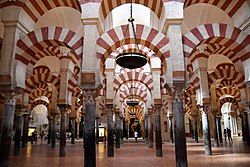Seni bina Islam
| |||||
Seni bina Islam terdiri daripada gaya seni bina bangunan yang dikaitkan dengan Islam. Ia merangkumi kedua-dua gaya sekular dan agama dari sejarah awal Islam hingga ke hari ini. Dunia Islam merangkumi kawasan geografi yang luas dari segi sejarah dari Afrika barat dan Eropah hingga Asia timur. Kesamaan tertentu dikongsi oleh gaya seni bina Islam di semua kawasan ini, tetapi dari masa ke masa, kawasan yang berbeza mengembangkan gaya mereka sendiri mengikut bahan dan teknik tempatan, dinasti dan penaung tempatan, pusat pengeluaran artistik kawasan yang berbeza, dan kadang-kadang gabungan agama yang berbeza.[1][2]
Seni bina Islam awal dipengaruhi oleh seni bina Rom, Byzantine, Iran, dan Mesopotamia dan semua tanah lain yang ditakluki oleh Muslim Awal pada abad ketujuh dan kelapan.[3][4][5][6][7] Lebih jauh ke timur, ia juga dipengaruhi oleh seni bina Cina dan India apabila Islam tersebar ke Asia Selatan dan Tenggara. Kemudian ia mengembangkan ciri-ciri yang berbeza dalam bentuk bangunan dan dalam hiasan permukaan dengan seni khat Islam, arabesque, dan motif geometri.[8] Elemen seni bina baharu seperti menara, muqarnas, dan gerbang multifoil telah dicipta. Jenis bangunan biasa atau penting dalam seni bina Islam termasuk masjid, madrasah, makam, istana, hammam (tempat mandi awam), hospis Sufi (cth. khanqah atau zawiyas), air pancut dan sabil, bangunan komersial (cth. karavanserais dan bazar), dan kubu tentera.[2]
Lihat juga[sunting | sunting sumber]
Rujukan[sunting | sunting sumber]
- ^ Tabbaa, Yasser (2007). "Architecture". Dalam Fleet, Kate; Krämer, Gudrun; Matringe, Denis; Nawas, John; Rowson, Everett (penyunting). Encyclopaedia of Islam, Three (dalam bahasa Inggeris). Brill. ISBN 9789004161658.
- ^ a b Bloom & Blair 2009, "Architecture".
- ^ Petersen 1996, halaman 295: "As the Arabs did not have an architectural tradition suited to the needs of a great empire, they adopted the building methods of the defeated Sassanian and Byzantine empires. Because they ruled from Syria, Byzantine influence was stronger, although Sassanian elements became increasingly important."
- ^ Ettinghausen, Grabar & Jenkins-Madina 2001, m/s. 7.
- ^ M. Bloom, Jonathan; S. Blair, Sheila, penyunting (2009). "Architecture". The Grove Encyclopedia of Islamic Art and Architecture. Oxford University Press. m/s. 74, 78. ISBN 9780195309911.
Although Syria remained the center of the Islamic empire for less than 90 years, its role in the development of Islamic architecture was crucial. The region's own ancient civilization, unified and transformed by Hellenization and overlaid with Roman and Christian elements, provided the basis for the new architectural style. The forms and conventions of Classical architecture were better understood in Syria than in the lands further east, and as a result some of the vocabulary of Umayyad architecture—of column and capital, pointed arch and dome, rib and vault—is familiar to a Western observer. These traditions declined in importance, however, as Muslim builders began to adopt the architectural styles of the newly conquered lands to the east—in Mesopotamia, Iran, Central Asia and even India. (...) The Abbasid dynasty of caliphs, founded in 749, ruled most of the Islamic lands from capital cities in Iraq during a golden age that lasted at least until the end of the 9th century. New styles of architecture were characterized by forms, techniques and motifs of Iraqi and Iranian origin. Some features of these styles, such as brick vaults and stucco renderings, had already appeared in buildings erected late in the Umayyad period (661–c. 750; see §III above), but they became increasingly widespread as a result of the power and prestige of the Abbasid court. In the Islamic lands around the Mediterranean, Late Antique traditions of stone construction roofed with wood continued, although new techniques and styles were eventually introduced from Iraq.
- ^ Grabar, Oleg (2011). "Art and Culture in the Islamic World". Dalam Hattstein, Markus; Delius, Peter (penyunting). Islam: Art and Architecture. h.f.ullmann. m/s. 36–37. ISBN 9783848003808.
At this stage of scholarly knowledge, however, it is probably fair to say that Islam's Arabian past, essential for understanding the faith and its practices, and the Arabic language and its literature, is not as important for the forms used by Islamic art as the immensely richer world, from the Atlantic Ocean to Central Asia, taken over by Islam in the 7th and 8th centuries. Even later, after centuries of independent growth, new conquests in Anatolia or India continued to bring new local themes and ideas into the mainstream of Islamic art.
- ^ Flood & Necipoğlu 2017, Frameworks of Islamic Art and Architectural History: Concepts, Approaches, and Historiographies: "Thus, it is increasingly being recognized that the mutual Roman–Byzantine architectural heritage of the Mediterranean, which had played an important role in the formation of early Islamic art, continued to mediate the shared histories of European and Islamic art long after the medieval period."
- ^ Bloom & Blair 2009, Ch.s "Architecture", "Ornament and pattern".
Bacaan lanjut[sunting | sunting sumber]
- Fletcher, Banister (1996) [1896]. Cruickshank, Dan (penyunting). Sir Banister Fletcher's a History of Architecture (ed. ke-20). Architectural Press. ISBN 978-0-7506-2267-7.
- Abdullahi, Yahya; Bin Embi, Mohamed Rashid (2013). "Evolution of Islamic geometric patterns". Frontiers of Architectural Research. 2 (2): 243–251. doi:10.1016/j.foar.2013.03.002.
- Abdullahi, Yahya; Bin Embi, Mohamed Rashid (2015). "Evolution Of Abstract Vegetal Ornaments on Islamic Architecture". International Journal of Architectural Research: ArchNet-IJAR. 9: 31. doi:10.26687/archnet-ijar.v9i1.558.
Pautan luar[sunting | sunting sumber]
- ARCHITECTURE OF ISLAM by Takeo Kamiya (Half in English and half in Japanese)
- ARCHNET Open access, online resource on architecture and art of Muslim societies, globally and throughout history to our times
- Fatimid-era Ayyubid Wall of Cairo Digital Media Archive (creative commons-licensed photos, laser scans, panoramas), data from an Aga Khan Foundation/CyArk research partnership
- Islamic Arts and Architecture website
- Tehranimages. Contemporary photos taken in some of the oldest districts of Tehran.
- 10,000+ Architectural collections worldwide Diarkibkan 7 Mei 2020 di Wayback Machine Islamic Art And Architecture designs worldwide.



